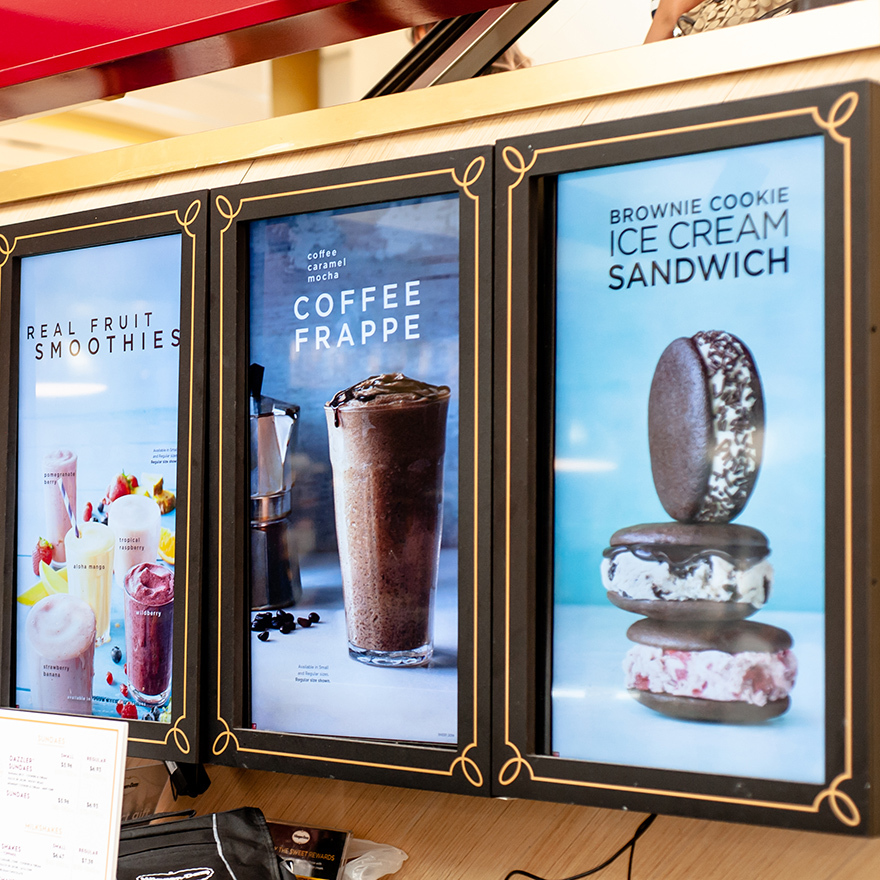Why TV Screens Don’t Work as Digital Menu Boards

“Can’t I just purchase a TV, plug in a jump drive, and run my menu using PowerPoint?”
— Every new restaurant owner
This is one of the most commonly asked questions we receive about digital menus at WAND Digital. After all, a screen is a screen, right? When it comes to hardware longevity, durability, and capabilities, we’re about to learn that a TV is no substitute for what a restaurant needs.
Sure, this DIY combination of a jump drive and typical consumer TV screen may work in a pinch for very small operators or short-term needs. However, this duo is definitely not a feasible, long-term solution for multi-unit restaurant concepts or restaurant operators who want worry-free, reliable equipment in their restaurants.
If you’re looking to upgrade your restaurant signage with digital menu technology, investing in commercial-grade screens is a smart move for both your customers and your bottom line.
Commercial-grade Digital Menu Boards vs. Consumer TV Screens
Consumer-grade TVs aren’t built to last.
The old adage “you get what you pay for” doesn’t break down when we talk about menu display technology. Consumer-grade TV screens only need to last for about 20,000 hours of operational time before failure in order to receive a UL listing (UL is ISO standards for display technology). If you run your displays for even just 12 hours per day, every day of the week, you’re looking at a 4-year lifespan in a best-case scenario.
Compare that milestone with a commercial-grade display that generally needs to provide three times the operational capacity. Looking at this as a value proposition, this means you’ll go through three of those “cheaper” displays in the same span of time as you would with just one of the more durable commercial-grade screens. In the long run, the cheaper option could end up costing you more than investing in a quality commercial-grade screen from the get-go.
TV screens can’t withstand a restaurant environment.
One thing we all know about the restaurant industry is it gets hot and greasy—fast. The typical TV screen is made to be viewed from the comfort of our temperature-controlled living rooms where they might endure a layer of dust and cat fur from time to time. The screens that operate for a few hours at a time (unless you’re binge-ing a particularly great series) aren’t designed to withstand the heat and grease of a quick-service or fast-casual restaurant.
As a result, the TV screens we pick up at the big box store aren’t likely to last longer than a couple of years in a restaurant setting. Commercial-grade screens, on the other hand, can take the heat and will last years longer in the conditions of QSRs and fast-casual restaurants. This durability and longevity gives restaurant owners peace of mind and their wallets a bit more cash.
Consumer TV warranties don’t cover commercial use.
Most TV screen warranties clearly detail that commercial use of the TV screen falls outside of the product’s warranty. Even if this isn’t the case for your TV screen, warranty repair work often requires that the owner bring the screen in for repair service. Imagine having to take down and transport your only menu display during an extremely busy day. (We all know that issues only arise on really busy days!)
Not only that, but how well will your business operate with only a portion of your menu on display? Most commercial-grade screen providers, in contrast, offer a warranty program that covers repairs and will ship and install a replacement or temporary screen when issues arise. For example, WAND’s warranty guarantees next-business day system repair or replacement, giving you added peace of mind that your equipment will always meet the demands of your restaurant.
TV screens have too many (unnecessary) settings.
Your typical TVs have lots of different settings that can be used to control color, brightness, channel labels, inputs, and more. If you’ve ever accidentally stumbled into the settings menu on your TV, and somehow turned everything green, you know what we’re talking about!
A restaurant manager may become extremely frustrated when setting or adjusting the TV settings properly to display their menu boards in their unique setting. Likewise, an employee may unknowingly change the TV screen settings and not know how to resolve the error. These situations are frustrating and, unfortunately, all too common. Commercial screens, however, include a tailored user interface that allows the operator to set up the screens and ensure they’re programmed to accurately display the menus.
Commercial-grade screens are built for rigorous and demanding environments, which means beefed up durability and capabilities that align with the needs of a business owner (and not a movie buff nestled in their home cinema). After all, there’s a reason that commercial-grade digital menu displays in lieu of off-the-shelf TVs.
Ready to learn how WAND Digital can help your restaurant grow?
Related Reading

Do More with Digital Displays
Scale your business, grow your brand, and delight more customers with the magic of digital menus and signs.


